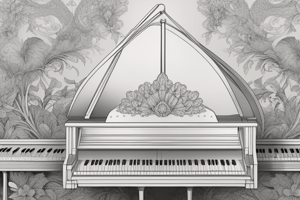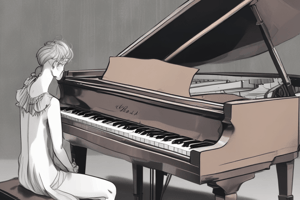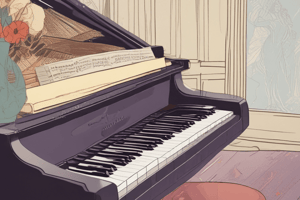Podcast
Questions and Answers
When positioning your body at the piano, what is the ideal height for your elbows?
When positioning your body at the piano, what is the ideal height for your elbows?
- Slightly above the keyboard level
- Significantly below the keyboard level
- Slightly below the keyboard level
- At the same level as the keyboard (correct)
What is the recommended position for your back when sitting at the piano?
What is the recommended position for your back when sitting at the piano?
- Well straight but not rigid to avoid tension (correct)
- Relaxed and slumped for comfort
- Perfectly straight and rigid to maintain posture
- Slightly curved forward to reach the keys easier
Why is it important to maintain a proper distance from the piano?
Why is it important to maintain a proper distance from the piano?
- To be able to see the keys and sheet music comfortably
- To allow for maximum arm extension and power
- To ensure that the wrists are always bent
- To discourage you from watching your fingers too closely (correct)
What should be the general shape of the hand when playing piano?
What should be the general shape of the hand when playing piano?
How many white keys are there on a standard 88-key piano?
How many white keys are there on a standard 88-key piano?
Which clef is typically used for the right hand on the piano?
Which clef is typically used for the right hand on the piano?
What do the numbers placed above or below musical notes indicate?
What do the numbers placed above or below musical notes indicate?
In musical notation, what is a 'staff' (portée)?
In musical notation, what is a 'staff' (portée)?
How many spaces are within a staff (portée)?
How many spaces are within a staff (portée)?
What is the function of a clef in musical notation?
What is the function of a clef in musical notation?
In the G clef (treble clef), which line indicates the position of the note 'G'?
In the G clef (treble clef), which line indicates the position of the note 'G'?
In the F clef (bass clef), which line indicates the position of the note 'F'?
In the F clef (bass clef), which line indicates the position of the note 'F'?
What does the term 'figure de note' refer to?
What does the term 'figure de note' refer to?
How many 'figures de notes' are there?
How many 'figures de notes' are there?
If a whole note receives 4 beats, how many beats does a half note receive?
If a whole note receives 4 beats, how many beats does a half note receive?
If a whole note receives 4 beats, how many beats does a quarter note receive?
If a whole note receives 4 beats, how many beats does a quarter note receive?
What is the term for musical notations that indicate silence?
What is the term for musical notations that indicate silence?
What does a time signature indicate in a musical piece?
What does a time signature indicate in a musical piece?
The top number in a time signature represents the amount of time the piece have.
The top number in a time signature represents the amount of time the piece have.
What does the lowering of the pitch a half step called?
What does the lowering of the pitch a half step called?
What is the term for a collection of sharps or flats at the beginning of a musical staff?
What is the term for a collection of sharps or flats at the beginning of a musical staff?
Which of the following is the closest definition for 'largo'?
Which of the following is the closest definition for 'largo'?
Which of the following dynamic markings indicates the loudest volume?
Which of the following dynamic markings indicates the loudest volume?
Flashcards
Piano body posture
Piano body posture
Correct body posture is crucial when playing piano. It allows for optimal reach and keyboard awareness.
Wrist position
Wrist position
Maintain a supple and somewhat firm wrist for expressive and rhythmic playing. The force comes from the wrist position.
Piano keys
Piano keys
Piano keyboards have 52 white and 36 black keys. These keys produce high and low sounds when played.
Fingering
Fingering
Signup and view all the flashcards
Musical notes
Musical notes
Signup and view all the flashcards
Musical staff
Musical staff
Signup and view all the flashcards
Clef
Clef
Signup and view all the flashcards
Treble and Bass Clefs
Treble and Bass Clefs
Signup and view all the flashcards
Note names
Note names
Signup and view all the flashcards
Reading notes
Reading notes
Signup and view all the flashcards
Note values
Note values
Signup and view all the flashcards
Round note
Round note
Signup and view all the flashcards
Silences
Silences
Signup and view all the flashcards
Time signature
Time signature
Signup and view all the flashcards
Simple time
Simple time
Signup and view all the flashcards
Alterations
Alterations
Signup and view all the flashcards
Sharps and flats
Sharps and flats
Signup and view all the flashcards
Music armors
Music armors
Signup and view all the flashcards
Point effect
Point effect
Signup and view all the flashcards
Liaison
Liaison
Signup and view all the flashcards
The accords
The accords
Signup and view all the flashcards
Pop Accord
Pop Accord
Signup and view all the flashcards
Volume Sign
Volume Sign
Signup and view all the flashcards
Musical Speed
Musical Speed
Signup and view all the flashcards
Articulations and reprisals
Articulations and reprisals
Signup and view all the flashcards
Study Notes
- This is a course notebook about how to play the piano.
- The course focuses on music theory and technique.
- The teacher is Alexis Dumais and their email address is [email protected]
Body Position at the Piano
- It's crucial not to sit too close to the piano, as beginners often want to reassure themselves and scrutinize their fingers.
- Proper distance enables a broader view, letting you observe your playing, the keyboard, and the sheet music.
- This distance should not be too far (arms stretched) or too close (wrists bent).
- The arm's angle should allow bending without reaching a right angle, with fingers above the keys.
- Forearms should be neither too high nor too low.
- Elbows should align with the keyboard level or slightly below, depending on arm length, to facilitate finger action.
- This position should feel natural, without strain in the arm, wrist, or hand.
- Keep the shoulders low and relaxed to allow body's flexibility.
Hand Position on the Piano
- Wrist position above the piano significantly impacts the touch nuance.
- Your wrist should be flexible for dynamic play yet firm enough for precise, rhythmic performance.
- The force of the finger strike depends on wrist position,
- Hold the hand in a vaulted form, as if holding a small apple.
- Adopting this hand shape results in the ideal piano playing hand.
Summary of body position
- The entire body's base involves flat feet, sometimes with one foot behind the stool for a specific sound.
- Sit well on the edge of the buttocks, not squarely facing the piano like a desk.
- Maintain a straight but not rigid back, feeling like a column in the core and kidneys.
- Keep elbows at keyboard height and shoulders free and relaxed.
- The arms should remain free and flexible.
- The wrists extend from the elbow, not bent downward at keyboard level.
- The body is positioned in front of the central C.
Piano Keyboard Composition
- The piano keyboard has 88 keys, including 52 white keys and 36 black keys.
- The tones on the piano are arranged from low sounds on the left, to high sounds on the right.
- Musical compositions for the piano are written on two musical staves.
- The upper stave is for the right hand.
- The lower stave is for the left hand.
Fingering Notation
- Small numbers above or below notes indicate which finger should play them, known as fingering.
- It is very important to always follow the fingering that is indicated
Basic Music Theory
- Music uses sound in place of words, written with notes instead of letters.
- Notes include Do, Re, Mi, Fa, Sol, La, and Si
- Notes are placed on a set of five parallel lines called staff or "portée" (French).
- The staff includes 5 lines and 4 spaces or "interlignes" (French).
- A clef indicates where to place notes, naming them.
- Piano music needs a different clef for each hand.
- The treble clef or "clé de Sol" (French) is for the right hand.
- The bass clef or "clé de Fa" (French) is for the left hand.
- Count staff lines and spaces from bottom to top.
- Since the treble clef ends on the 2nd line, all notes on it are named Sol.
- The bass clef starts on the 4th line, and encircles this line with two points, all notes on which are named Fa.
- Knowing note order makes deducing other note positions on the staff simple.
Lines and Spaces in Treble Clef (Clé de Sol)
- The lines are Mi, Sol, Si, Re, and Fa from bottom to top.
- The spaces are Fa, La, Do, and Mi from bottom to top.
Lines and Spaces in Bass Clef (Clé de Fa)
- The lines are Sol, Si, Re, Fa, and La from bottom to top.
- The spaces are La, Do, Mi, and Sol from bottom to top.
Note and Rest Values
- The note name and position on the staff indicate pitch.
- Sounds vary in duration from short to long.
- The 'figure de note' or note shape indicates how long a tone should last.
- A whole note/La RONDE has the longest duration, with values decreasing through a series of note types.
- Each standard 7 notes are La RONDE, La BLANCHE, La NOIRE, La CROCHE, La DOUBLE-CROCHE, La TRIPLE-CROCHE, LA QUADRUPLE-CROCHE.
Note and rest values breakdown
- One whole note equals two half notes.
- One whole note equals four quarter notes.
- One whole note equals eight eight notes.
- One half note equals two quarter notes.
- One half note equals four eight notes.
- One quarter note equals two eight notes.
Musical Silences
- Music features signs for sounds (notes) and for the pauses between them, called silences or rests.
- The duration of silences measures similarly to note duration.
- Each note value has a corresponding rest value,
Rests and Pauses
- A whole rest/La PAUSE, equals the length of a La RONDE (whole note).
- A half rest/ LA DEMI-PAUSE, equals a La BLANCHE (half note).
- A quarter rest/ LE SOUPIR, equals a La NOIRE (quarter note).
- An eighth rest/LE DEMI-SOUPIR, equals a La CROCHE (eight note).
- A sixteenth rest/LE QUART DE SOUPIR, equals a DOUBLE-CROCHE (sixteenth note).
Notation Rules for Rests
- The whole rest or "LA PAUSE (4 temps)" always goes below the 4th line,
- The half rest or "LA DEMI-PAUSE (2 temps)" appears on the 3rd line.
- Eighth note rests or "Le soupir" is written in 2 ways, either in print or in handwriting, and is under the 4th line.
Time Signatures
- A piece of music divides into equal segments called measures or "mesure" (French), marked by vertical lines on the staff.
- A simple measure is composed of 2, 3, or 4 beats or "temps" (French).
- Time signatures define the content of a measure using fraction like numbers.
- The numerator or top number indicates how many beats are in a measure.
- The denominator or bottom number indicates which note value equals one beat.
- A denominator of 1 means the whole note is one beat, 2 means the half note is one beat, 4 means the quarter note is one beat, and so on.
Musical Alterations
- A half step or "demi-ton" (French) is the shortest interval between two notes on the keyboard.
- Sharps, flats, and naturals alter pitch.
- A sharp raises a note by a half step.
- A flat lowers it by a half step.
- A natural cancels the effect of a sharp or flat.
- Alterations appear before the note on the staff at the same height, whether on a line or space.
- Any piano key may have several names, such as mi # and fa.
Key Signatures
- Sharps or flats at the beginning of a piece between the clef and the time signature form a key signature or armure (French).
- Key signatures tell the musician to always play specific notes sharp or flat throughout the piece.
- Accidentals within a measure not indicated by the key signature only apply inside that measure.
Augmenting Note Value
- To lengthen a note, add a dot to its body, never beside its stem.
- The dot adds half of the original note's value to itself.
- A dotted whole note is equal to a whole note plus a half note, totaling six beats instead of four.
- This means that a dotted whole note equals three half notes.
- A scale of dotted note or rest values ascends in sets of three.
- A tie combines two notes of the same pitch, adding the second note's length to the first without re-striking it.
Other notations
- Staccato marks shorten notes, played as a short sound.
- Fermatas extend the duration based on interpretation.
Pop Symbol Note Names
- Letter names for the scale are A-B-C-D-E-D-G which are La, Si, Do, Re, Mi, Fa, and Sol respectively.
- When chords are at the fundamental level, you indicate just one letter above the staff.
- Inverted chords get a slash under the name to indicate the lowest note of the chord.
Chords
- An ACCORD is the result of playing several keys in a single hand at the same time or simultaneously in both hands.
- An accord can built upon each level of the scale.
- Basic chords are the foundation and formed of 3 notes with 3 lines or spaces that can be played with the fingers 1-3-5.
- It is the lowest note of the accord that is the foundation from which the notes are added to build the chords.
Different chords
- These have 3 sounds and the most important is the difference between the major chords and the minor chords.
- When the accord is at the foundation level, the difference makes the tierce different.
- 2 tones make up a major tierce, 1.5 tones for the minor.
- In general, when adding minor accords in pop cords, you can add M to the letter.
Harmonic Intervals
- A fundamental harmonic interval is composed of tierce majeure plus mineure as well as a quinte juste.
- 7 demi-tons make ups the harmonic interval (3 tones with 1/2)
Elements of Musical Performance
- Nuances indicate the intensity of a note, phrase, or passage.
Gradations of Nuances
- pp: pianissimo or very soft
- p: piano or soft
- mp: mezzo piano or medium soft
- mf: mezzo forte or medium loud
- f: forte or loud
- ff: fortissimo or very loud
Tempo
- The tempo indicates how fast to play a piece.
- largo: large or slow
- lento: slow
- adagio: at ease
- moderato: moderate
- allegro: cheerful, lively
- presto: rapid
- rallentendo: slowing down
- ritenuto: holding back
Articulations and Repetitions
- legato: connected
- staccato: short
Musical Symbols
- Accent marks add force to notes.
- Repeat signs indicate replaying sections.
- D.S. al coda means repeat from the sign to the coda.
- The coda mark directs to skip ahead.
- Led. indicates that you are use the pedal for the notes.
Studying That Suits You
Use AI to generate personalized quizzes and flashcards to suit your learning preferences.




